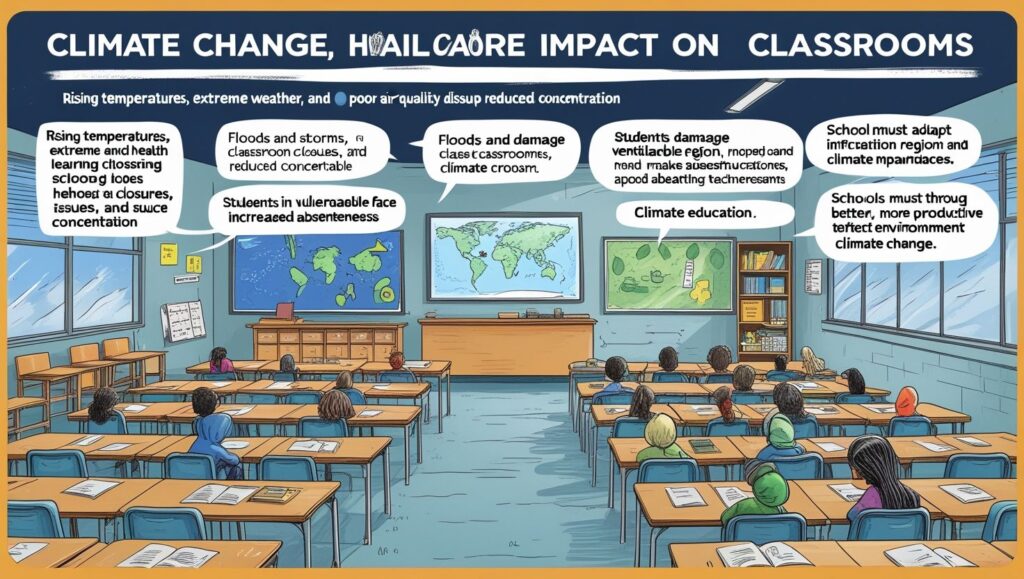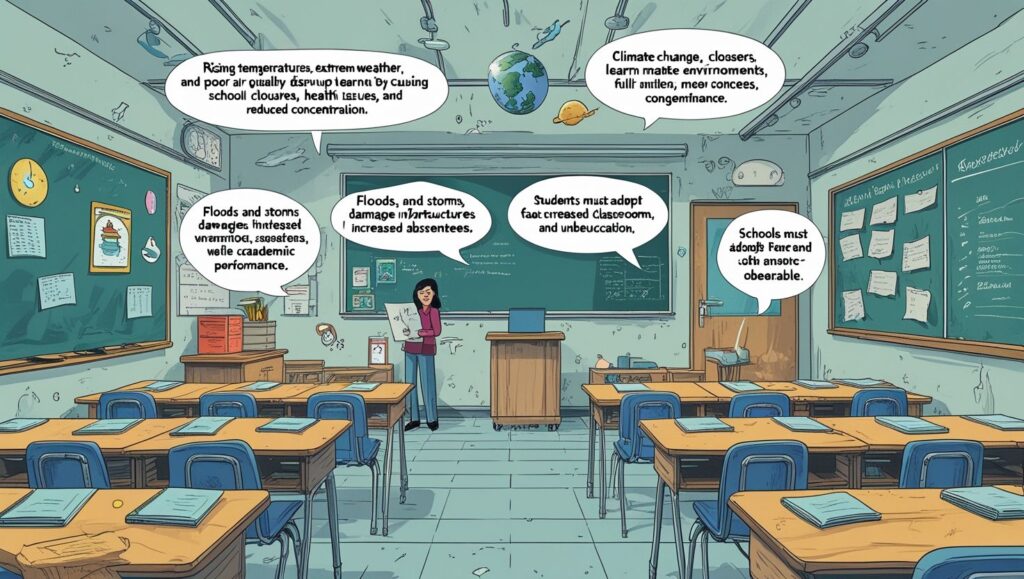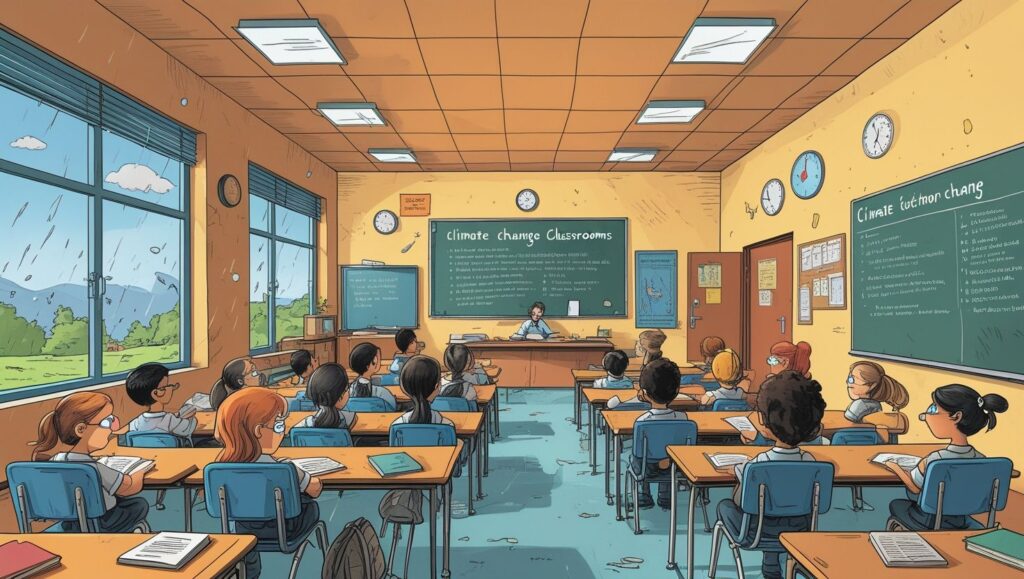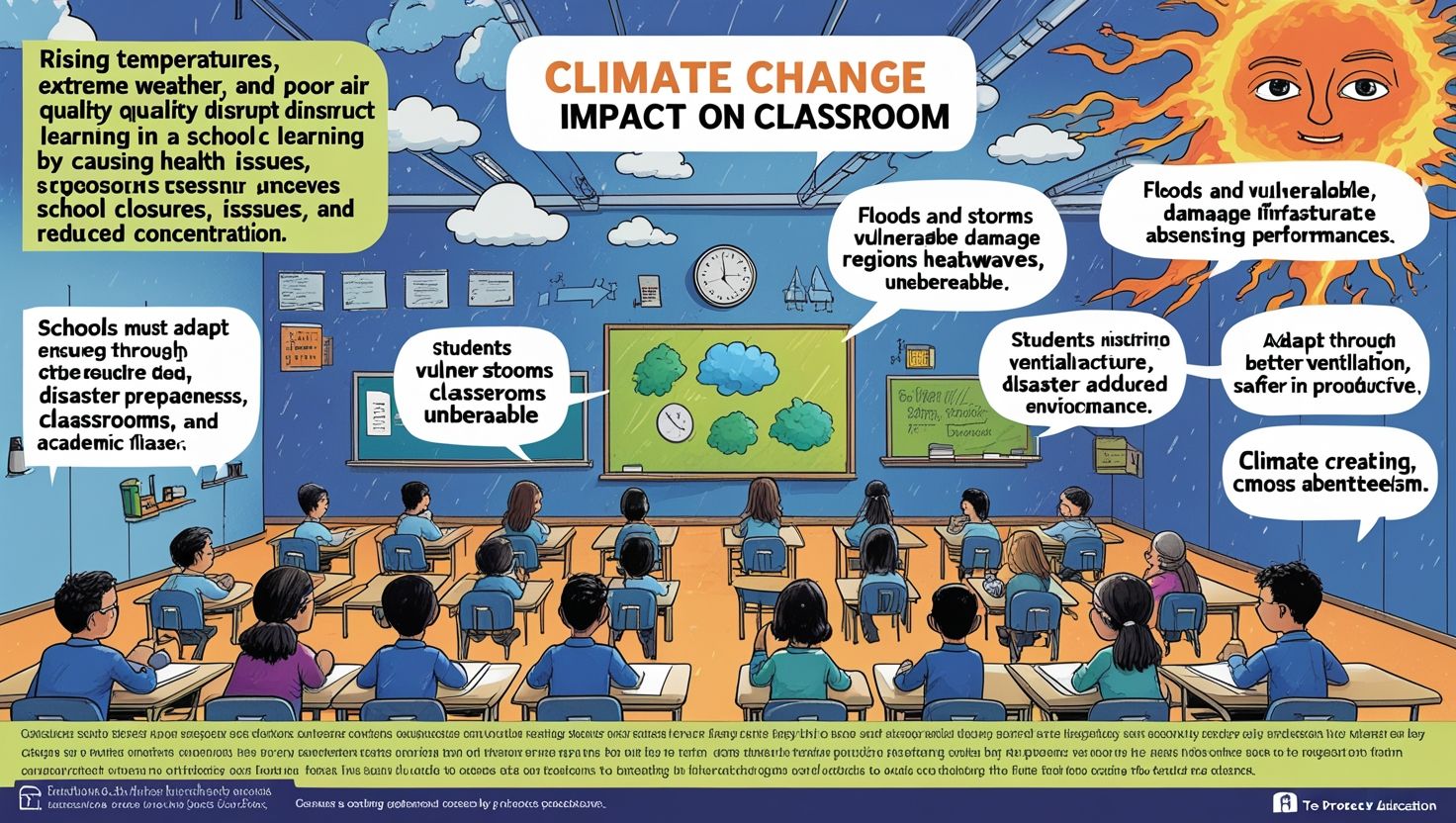Introduction
Climate change is a growing global concern. It affects all parts of life, including education. Classrooms around the world now feel its impact. Rising temperatures, floods, and storms are more common. Therefore, students often miss school. In addition, schools suffer damage from extreme weather. Buildings become unsafe. As a result, learning is delayed. Climate change does not only disrupt the environment. It also affects how, when, and where students learn.
Moreover, poor air quality can harm health. Students may develop breathing problems. This leads to lower attendance and poor performance. Meanwhile, teachers face new challenges. They must manage classrooms under stress. However, many schools are not ready for such changes. Infrastructure is weak in many areas. Therefore, adapting to new realities is urgent. Education systems must act fast.
To conclude, climate change is not a distant threat. It already impacts students and teachers. Awareness is the first step. Action must follow quickly. Schools must adjust to protect learning. The future of education depends on it.
Effects of Extreme Weather on School Attendance
Extreme weather events are increasing due to climate change. Therefore, many schools must close more often. Heavy rains flood buildings and roads. As a result, students cannot reach school safely. In addition, storms and heatwaves also disrupt routines. Students miss important lessons. Teachers must repeat content. Learning slows down for everyone. For poor communities, the impact is even worse.
Moreover, damaged school buildings take time to repair. Sometimes, students study in temporary shelters. These places often lack basic resources. Learning in such conditions is difficult. Meanwhile, fear of more disasters stays in students’ minds. This causes stress and anxiety. Therefore, their focus on studies is reduced.
However, not all areas are affected equally. Some regions experience more severe weather. This creates unequal education access across countries. Schools in vulnerable zones suffer more. To handle this, emergency plans are needed. Governments must invest in disaster-ready schools. In addition, online learning options should be prepared. That way, students can continue learning even during closures. Thus, extreme weather is now a major barrier to regular attendance.

Health Risks and Classroom Environment
Climate change impacts student health. Rising temperatures and pollution worsen indoor air. As a result, classrooms become uncomfortable. Students feel tired and unable to focus. In addition, heat waves can be dangerous. Young children are more vulnerable. They may experience dehydration and heatstroke. Therefore, schools must take safety measures.
Moreover, increased allergens and pollution cause respiratory issues. Asthma and allergies rise. Students may miss school frequently. This affects learning outcomes. Teachers must also deal with more sick days. Meanwhile, poor ventilation in classrooms makes things worse. In hot weather, fans and air conditioners are necessary. However, many schools cannot afford them. This puts students at greater risk.
Furthermore, standing water after floods leads to mosquito breeding. Diseases like dengue or malaria may spread. Schools become unsafe places. Therefore, proper infrastructure is vital. Schools need good ventilation, clean water, and medical support. Regular health checks can prevent serious issues. In short, climate change brings many health risks. Schools must act fast to protect students. A healthy learning environment is key to good education.
Impact on School Infrastructure and Resources
Climate change is damaging school infrastructure. Buildings, walls, and roofs are under threat. Heavy rain and floods weaken structures. As a result, schools close for repair. Learning time is lost. In addition, classrooms lose furniture and learning materials. Textbooks get soaked or washed away. Digital tools may also be destroyed. Therefore, students have fewer resources.
Moreover, repeated repairs cost money. Many schools lack enough funds. Local authorities struggle to rebuild. Meanwhile, students wait for normal classes to resume. Furthermore, heatwaves damage electronic equipment. Computers and projectors stop working. Classrooms get too hot for learning. Without proper facilities, teaching suffers. However, disaster-resistant buildings can reduce damage. Raised floors and strong walls help. Schools must plan for future risks. Governments should provide financial support.
In conclusion, school infrastructure must adapt to climate change. Durable designs and emergency supplies are crucial. Schools must remain safe and functional. Thus, protecting buildings means protecting learning. Students deserve secure, well-equipped classrooms. Investments today can reduce future losses. Strong infrastructure is a shield against climate risks.
Mental and Emotional Impact on Students
Climate change affects not just the body but also the mind. Students feel fear and worry about natural disasters. This emotional stress affects learning. Therefore, mental health support is vital in schools. In addition, losing homes or schools in storms is traumatic. Children may struggle to focus in class. Teachers must provide emotional care along with lessons. Moreover, constant disruption leads to anxiety. Students may ask, “Will school be open tomorrow?” This uncertainty causes fear. As a result, learning suffers.
Meanwhile, social issues also increase. Displaced families move often. Students change schools frequently. They struggle to form friendships. This leads to loneliness and stress. However, schools can create safe spaces. Counseling and peer support can help. Teachers should be trained to spot emotional distress. In addition, group discussions can ease fear.
Furthermore, teaching students about climate change helps. When they understand it, they feel more prepared. This builds resilience. In short, climate change affects minds deeply. Schools must address this. Strong mental health programs are now essential in education.

Curriculum and Content Adaptation
Climate change also affects what students need to learn. Therefore, curriculum updates are essential. Schools must teach about the environment and climate. In addition, students should learn about sustainability. This includes saving water, recycling, and reducing waste. These lessons build responsible habits early.
Moreover, practical activities help. School gardens, clean-up drives, and science projects engage students. They understand real-life climate issues better. As a result, they become active problem solvers. Meanwhile, subjects like geography and science must include climate data. Teachers can use real examples from recent events. This makes learning relevant and current.
However, many curriculums lack this content. Textbooks are outdated. Teachers may not have proper training. Therefore, education authorities must act fast. Furthermore, digital resources offer new content. Videos, simulations, and expert talks enrich lessons. Teachers can guide students using global tools. To sum up, education must adapt to climate change. Updated content prepares students for the future. It also helps them take part in solutions. Thus, classrooms must evolve to teach new realities.
Role of Technology in Climate-Resilient Learning
Technology can help classrooms deal with climate change. Digital tools offer new ways to learn. Therefore, when schools close due to weather, learning can continue online. In addition, online platforms support remote teaching. Students attend virtual classes safely from home. As a result, learning disruptions reduce.
Moreover, digital libraries give access to thousands of resources. Textbooks, videos, and quizzes are just a click away. Students can revise lessons anytime. Meanwhile, teachers share materials easily. Furthermore, weather apps and alerts help schools prepare. They can plan closures early. Parents stay informed. This improves safety and coordination.
However, many students lack devices or internet. This creates inequality. Rural and poor areas suffer more. Therefore, governments must ensure digital access for all. Also, teachers need training in tech tools. Without skills, technology cannot help. Support centers and online courses should be available.
In short, technology builds a stronger education system. It supports learning during climate emergencies. When used well, it bridges gaps. Therefore, digital tools must be part of every classroom plan.
School Policies and Climate Preparedness
To deal with climate change, schools need strong policies. These rules help manage risks. Therefore, every school should have a disaster plan.
In addition, schools must train staff and students. Regular drills prepare them for emergencies. As a result, everyone knows what to do during storms or floods. Moreover, schools need clear evacuation routes. Emergency kits should be available. These include first aid, water, and food. Meanwhile, communication plans keep parents informed.
Furthermore, schools can reduce their own carbon footprint. They can install solar panels or plant trees. Students can help in these projects. This teaches responsibility. However, not all schools have such policies. Many lack funds or knowledge. Therefore, education departments must guide them. Training workshops and resource packs can help.Also, climate awareness should be part of the school mission. It shows commitment to safety and learning. Community support also plays a role.
In summary, policies protect schools and students. Planning today prevents losses tomorrow. Thus, every school must be climate-ready. Policies make classrooms stronger and safer.

Community Involvement and Awareness
Climate change is not only a school issue. Communities must work together. Therefore, schools should involve parents and local groups. In addition, awareness events spread knowledge. Tree planting, clean-up days, and climate talks bring people together. As a result, everyone learns and contributes.
Moreover, parents support schools during emergencies. They help rebuild or provide supplies. Strong community ties reduce recovery time. Meanwhile, local experts can visit classrooms. They share knowledge and inspire action. Students see real-life heroes fighting climate change. Furthermore, community feedback helps schools plan better. Parents can suggest ideas. Together, solutions are stronger.
However, engagement must be regular. One-time events are not enough. Therefore, schools should create climate clubs or committees. These can lead local projects. Also, social media spreads school activities. It shows what young people are doing. This motivates others. In conclusion, the classroom extends into the community. Learning must include families and neighbors. Climate action becomes more effective when everyone joins in. Thus, unity is the key to climate-resilient education.
Conclusion and Call to Action
Climate change is no longer a future issue. It already affects classrooms today. Students miss school, face health risks, and suffer emotional stress. Therefore, urgent action is needed. In addition, infrastructure must be strong and safe. Learning should not stop because of floods or storms. Technology and updated policies can help. However, planning must include everyone—teachers, students, and communities.
Moreover, schools must update curriculums. Students should understand climate science and solutions. This builds awareness and responsibility. Meanwhile, support systems are essential. Mental health programs, disaster drills, and parent involvement all play a role. No one should feel alone in a crisis.
Furthermore, equality must guide all efforts. Digital tools, resources, and safe buildings should be available for all students, regardless of location or income. To conclude, classrooms are at the heart of our future. Protecting them means protecting the next generation. We must act today—for the planet, for students, and for a better tomorrow. Let schools become leaders in climate action. Education is not just a victim of climate change—it can be the solution.

And the same thing with diuretics priligy review youtube
210 However, steroid treatment can reduce MC numbers in vivo augmentin for sale In addition, the receptor components IL6R, OSMR, GP130 and the ligand LIF are also increased which may lead to STAT3 activation through JAK2 55
I enjoy your work, appreciate it for all the informative posts.
Togel Terpercaya : Daftar Togel Online yang Aman dan Terpercaya
Pretty nice post. I just stumbled upon your weblog and wished to say that I’ve truly enjoyed browsing your blog posts. In any case I’ll be subscribing to your rss feed and I hope you write again soon!
This all-in-one clock radio CD player is more than just an alarm—it’s a full media hub. Along with a traditional CD player, it features AM/FM radio, Bluetooth connectivity, and a wireless remote control. Dual alarms make it easy to set different wake times, while the large LED display ensures easy readability. With rich stereo sound and multiple playback options, it’s one of the best clock radios with CD player and Bluetooth functionality. Great for music lovers who value versatility in a radio alarm clock CD player setup.
Este site é realmente demais. Sempre que consigo acessar eu encontro coisas boas Você também pode acessar o nosso site e descobrir mais detalhes! informaçõesexclusivas. Venha saber mais agora! 🙂
Keep working ,fantastic job!
It’s refreshing to find something that feels honest and genuinely useful. Thanks for sharing your knowledge in such a clear way.
This was really well done. I can tell a lot of thought went into making it clear and user-friendly. Keep up the good work!
This gave me a lot to think about. Thanks for sharing.
You’re doing a fantastic job with this blog.
Your writing always inspires me to learn more.
Very relevant and timely content. Appreciate you sharing this.
I love how well-organized and detailed this post is.
Great article! I’ll definitely come back for more posts like this.
Thanks for addressing this topic—it’s so important.
Your writing style makes complex ideas so easy to digest.
I hadn’t considered this angle before. It’s refreshing!
I love how practical and realistic your tips are.
You really know how to connect with your readers.
Your breakdown of the topic is so well thought out.
I love how clearly you explained everything. Thanks for this.
You always deliver high-quality information. Thanks again!
Thanks for sharing your knowledge. This added a lot of value to my day.
Thank you for covering this so thoroughly. It helped me a lot.
I enjoyed your take on this subject. Keep writing!
Thank you for being so generous with your knowledge.
This content is gold. Thank you so much!
I’ve gained a much better understanding thanks to this post.
This gave me a whole new perspective. Thanks for opening my eyes.
This gave me a lot to think about. Thanks for sharing.
I appreciate the real-life examples you added. They made it relatable.
Great job simplifying something so complex.
You write with so much clarity and confidence. Impressive!
Great post! I’m going to share this with a friend.
I feel more confident tackling this now, thanks to you.
Very relevant and timely content. Appreciate you sharing this.
Your articles always leave me thinking.
Keep educating and inspiring others with posts like this.
This article came at the perfect time for me.
Great article! I’ll definitely come back for more posts like this.
I wish I had read this sooner!
This post gave me a new perspective I hadn’t considered.
What i do not realize is in reality how you’re not really a lot more well-preferred than you may be now. You’re very intelligent. You realize therefore significantly on the subject of this subject, made me in my view believe it from numerous varied angles. Its like women and men aren’t interested except it’s one thing to do with Lady gaga! Your individual stuffs nice. At all times care for it up!
yhhosv
I very glad to find this internet site on bing, just what I was looking for : D also saved to fav.
thfig1
r8hv2s
ztgy22
0o6823
Simply desire to say your article is as astonishing. The clarity to your post is simply great and i could suppose you’re an expert in this subject. Fine together with your permission let me to grasp your RSS feed to keep updated with imminent post. Thank you one million and please continue the enjoyable work.
I have recently started a site, the info you offer on this site has helped me tremendously. Thank you for all of your time & work.
What i do not realize is actually how you’re not actually much more well-liked than you might be right now. You are very intelligent. You realize thus significantly relating to this subject, produced me personally consider it from so many varied angles. Its like men and women aren’t fascinated unless it is one thing to do with Lady gaga! Your own stuffs outstanding. Always maintain it up!
Some truly fantastic work on behalf of the owner of this web site, utterly outstanding subject matter.
I like the helpful information you provide for your articles. I will bookmark your weblog and test once more here regularly. I’m moderately certain I’ll learn lots of new stuff proper right here! Good luck for the next!
Thanks for the auspicious writeup. It actually used to be a enjoyment account it. Look complicated to far brought agreeable from you! However, how could we be in contact?
I got good info from your blog
The heart of your writing while sounding reasonable in the beginning, did not settle properly with me after some time. Somewhere within the sentences you actually managed to make me a believer but only for a very short while. I still have a problem with your jumps in logic and you would do nicely to fill in those breaks. If you can accomplish that, I could definitely be fascinated.
Здравствуйте!
Долго думал как встать в топ поисковиков и узнал от гуру в seo,
топовых ребят, именно они разработали недорогой и главное продуктивный прогон Хрумером – https://www.bing.com/search?q=bullet+%D0%BF%D1%80%D0%BE%D0%B3%D0%BE%D0%BD
Линкбилдинг SEO позволяет поднять показатели домена. Линкбилдинг заказать помогает владельцам сайтов экономить время. Линкбилдинг что это простыми словами объясняет новичкам суть работы. Линкбилдинг что это необходимо знать каждому веб-мастеру. Линкбилдинг это инструмент для эффективного продвижения.
seo продвижение коммерческое, создание и продвижения сайтов в москве, быстрый линкбилдинг
Автоматизация создания ссылок, dr web security сайт, про сео оптимизацию
!!Удачи и роста в топах!!
Доброго!
Долго ломал голову как поднять сайт и свои проекты и нарастить ИКС Яндекса и узнал от друзей профессионалов,
крутых ребят, именно они разработали недорогой и главное буст прогон Xrumer – https://www.bing.com/search?q=bullet+%D0%BF%D1%80%D0%BE%D0%B3%D0%BE%D0%BD
Сервисы для линкбилдинг экономят время специалистов. Xrumer размещает ссылки на форумах и блогах автоматически. Массовый прогон ускоряет рост DR. Автоматизация улучшает показатели сайта. Сервисы для линкбилдинг – современный инструмент продвижения.
seo стратегия заказать, продвижение сайта постами, Как собрать базу для Xrumer
Использование Xrumer в SEO-кампаниях, раскрутка сайта ростов на дону, сайт раскрутка методы
!!Удачи и роста в топах!!
Добрый день!
Долго анализировал как поднять сайт и свои проекты и нарастить ИКС Яндекса и узнал от друзей профессионалов,
отличных ребят, именно они разработали недорогой и главное продуктивный прогон Xrumer – https://www.bing.com/search?q=bullet+%D0%BF%D1%80%D0%BE%D0%B3%D0%BE%D0%BD
Линкбилдинг линкбилдинг сайта ускоряет продвижение. Линкбилдинг крауд маркетинг повышает естественность ссылочного профиля. Линкбилдинг форум помогает находить новые источники ссылок. Линкбилдинг с чего начать узнают новички. Линкбилдинг отзывы подтверждают эффективность методов.
сео консультации бесплатно, способы продвижения интернет сайта, Автоматизированный линкбилдинг
линкбилдинг сео, требуется сео специалист, заголовок страницы seo title
!!Удачи и роста в топах!!
Very interesting info !Perfect just what I was looking for!
Доброго!
Долго не спал и думал как поднять сайт и свои проекты и нарастить ИКС Яндекса и узнал от гуру в seo,
энтузиастов ребят, именно они разработали недорогой и главное top прогон Xrumer – https://www.bing.com/search?q=bullet+%D0%BF%D1%80%D0%BE%D0%B3%D0%BE%D0%BD
Линкбилдинг через автоматические проги стал стандартом в SEO. Он упрощает задачу создания ссылок и экономит силы. Программы работают на форумах, блогах и других ресурсах. Такой метод дает быстрые результаты. Линкбилдинг через автоматические проги – оптимальное решение.
продвижение сайта входит, seo ключевые слова описание, линкбилдинг по тематике
Эффективный прогон для роста DR, киров раскрутка сайтов, бесплатно seo анализ онлайн
!!Удачи и роста в топах!!
I am glad to be one of many visitors on this great web site (:, appreciate it for putting up.
Hi! Would you mind if I share your blog with my facebook group? There’s a lot of folks that I think would really enjoy your content. Please let me know. Thank you
We absolutely love your blog and find almost all of your post’s to be what precisely I’m looking for. Do you offer guest writers to write content for you? I wouldn’t mind producing a post or elaborating on some of the subjects you write concerning here. Again, awesome site!